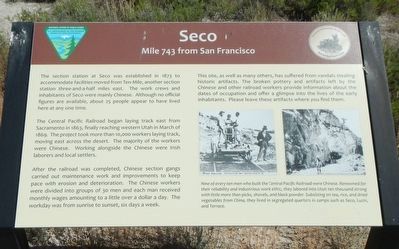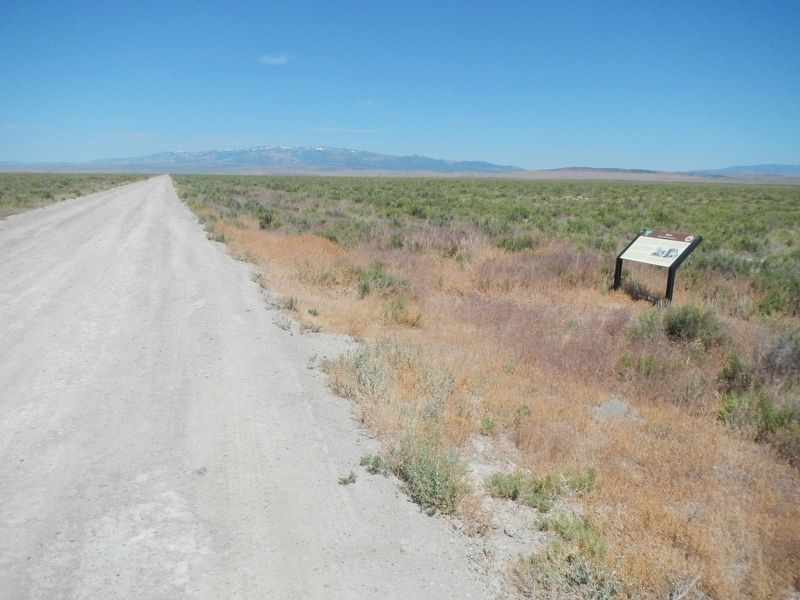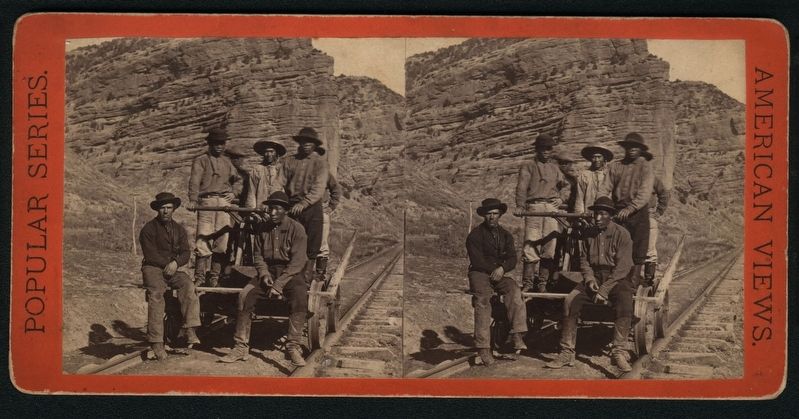Near Snowville in Box Elder County, Utah — The American Mountains (Southwest)
Seco

Photographed By Barry Swackhamer, June 20, 2017
1. Seco Marker
Caption: Nine of every ten men who built the Central Pacific were Chinese, Renowned for their reliability and industrious work ethic, they labored into Utah, tens of thousands strong with little more than picks, shovels, and black powder. Subsisting on tea, rice, and dried vegetables from China, they lived in segregated quarters in camps such as Seco, Lucin, and Terrance.
The section station at Seco was established in 1873 to accommodate facilities moved from Ten-Mile, another section station three-and-a-half miles east. The work crews and inhabitants of Seco were mainly Chinese. Although no official figures were available, about 25 people appear to have lived here at one time.
The Central Pacific Railroad began laying track east from Sacramento in 1863, finally reaching western Utah in March of 1869. The project took more than 10,000 workers laying track, moving east across the desert. The majority of workers were Chinese. Working alongside the Chinese were Irish laborers and local settlers.
After the railroad was completed, Chinese section gangs carried out maintenance work and improvements to keep pace with erosion and deterioration. The Chinese workers were divided into groups of 30 men each man received monthly wages amounting to a little over a dollar a day. The workday was from sunrise to sunset, six days a week.
This site, as well as many others, has suffered from vandals stealing historic artifacts. The broken pottery and artifacts left by the Chinese and other railroad workers provided information about the dates of occupation and offer a glimpse into the lives of the early inhabitants. Please leave these artifacts where you find them.
Erected by Department of the Interior, Bureau of Land Management.
Topics and series. This historical marker is listed in this topic list: Railroads & Streetcars. In addition, it is included in the Transcontinental Railroad series list. A significant historical year for this entry is 1873.
Location. 41° 44.424′ N, 112° 56.238′ W. Marker is near Snowville, Utah, in Box Elder County. Marker is on Transcontinental Railroad Back Country Byway, on the left when traveling west. Touch for map. Marker is in this post office area: Snowville UT 84336, United States of America. Touch for directions.
Other nearby markers. At least 6 other markers are within 9 miles of this marker, measured as the crow flies. Nella Siding (approx. 0.9 miles away); Ten-Mile (approx. 3.4 miles away); Elinor (approx. 4 miles away); Bidwell/Bartleson Trail - Monument Point (approx. 5.4 miles away); Monument (approx. 5˝ miles away); Kelton (approx. 9 miles away).
More about this marker. The Transcontinental Railroad Back Country Byway is a 90 mile dirt/gravel track on top of or beside the old Central Pacific Rail Road grade between Old Lucin and Promontory Summit. Other than markers designating old station and sidings there are few, if any, road signs identifying any of the side roads. Any other road names or numbers use on this marker page have been taken Google Maps which identifies the Byway variously as Golden Spike Loop Road, Old Railroad Grade Road, Salt Wells Road, etc.
Neither are there any mileage posts, though one could do the arithmetic using the "Mile ... from San Francisco" on the markers to determine distances. Nor is there any mail delivery, so no street addresses either.
Credits. This page was last revised on July 11, 2017. It was originally submitted on July 11, 2017, by Barry Swackhamer of Brentwood, California. This page has been viewed 419 times since then and 39 times this year. Photos: 1, 2, 3. submitted on July 11, 2017, by Barry Swackhamer of Brentwood, California.

